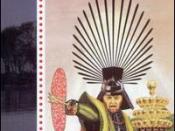Shim Gum Do
As the saying goes, "opposites attract". Nowhere is this more clearly demonstrated than by Shim Gum Do practices. Shim Gum Do is a Buddhist practice that employs the use of martial arts as a form of Zen. Meditation is commonly identified with stillness and martial arts with action, but by practicing them in unison the followers of Shim Gum Do aim to achieve enlightenment, just as their teacher and founder of the practice, Master Chang Sik Kim, did almost 40 years ago. The doctrines and practices of martial arts Zen are the product of multicultural influences and a long, rich history that has recently been brought to life by the parishioners of the Boston Shim Gum Do Temple.
History of Zen and the Martial Arts
Buddhism in practice began around the year 500 B.C. by the Buddha, Siddharta Gautama, a prince of present day Nepal. Gautama abandoned his royal lifestyle in response to all the pain and suffering that he saw around him.
It was during his time of solitude that Gauatma achieved his goal of becoming the "enlightened one", or Buddha and discovered that all the pain and suffering he had observed were not quite as bad as he had thought. These things are not permanent conditions, but rather are subject to change like anything else in the world. (Robinson and Johnson, 1997). About 25 years later a teacher named Bodhidharma traveled from India to China to teach his traditions of meditation. In China many of the Buddhist practices were combined with Taoism in what is referred to as Ch'an Buddhism. When the school of thought reached Japan and Korea around 1200 A.D. it adopted the prefix Zen, a Sanskrit word meaning "meditation". (Low, 1998).
The practice of martial arts is thought to have originally...


